
[ez-toc]
Introduction
The need for robust commercial EV charging station solutions in various commercial spaces becomes more crucial than ever. Businesses that install these charging stations have an excellent opportunity to support sustainability and meet the demands of a progressively eco-conscious customer base. In addition to environmental benefits, commercial spaces are prime locations for EV charging stations. These installations align with ecological goals and offer significant business benefits. By catering to the growing number of EV owners, businesses can increase foot traffic, enhance brand image, and create new revenue streams.
The Growth of the EV Market
The market for electric vehicles has quickly grown in recent years. Global electric car sales in 2021 hit a remarkable 6.6 million, exceeding the growth rate from the prior year, as the International Energy Agency (IEA) reported. The continuing increase is not expected to decrease, influenced by technological advancements, a global shift towards lessening carbon emissions, and government policies favoring this trend. Technological advancements have significantly enhanced battery life and reduced charging times, making EVs more practical and attractive to consumers. With concerns about climate change and air pollution, many people turn to electric vehicles as a cleaner alternative to traditional gasoline-powered cars. Governments are also crucial in driving the growth of the EV market by providing incentives and setting ambitious adoption targets.
Benefits of EV Charging Stations for Businesses
- Attract Customers: Electric vehicle owners often choose their shopping and dining destinations based on the availability of charging stations. Businesses that offer EV charging options become more attractive to this demographic, potentially driving more foot traffic and increasing sales.
- Enhance Employee Satisfaction: Offering EV charging solutions for employees who own electric vehicles can significantly boost job satisfaction and foster loyalty. Employees appreciate the convenience of charging their cars while they work, which can also serve as an added perk or benefit of working at the organization.
- Support Sustainability Goals: Installing EV chargers helps businesses reduce their carbon footprint, aligning with broader environmental and sustainability initiatives. By demonstrating a commitment to sustainability, businesses enhance their corporate social responsibility (CSR) image, which can appeal to both customers and partners.
- Create Additional Revenue Streams: Businesses can generate extra income through charging fees, which can help offset the initial investment in the infrastructure. With policies encouraging EV usage, more drivers will seek out commercial charging stations, providing businesses with new revenue opportunities.
Types of Charging Stations Available
Various types of EV charging stations are available to suit different needs and situations:
- Level 1 Chargers: These chargers use standard 120-volt outlets, are portable and cost-effective, but charge EVs slowly. They are best suited for home use or locations where vehicles will be parked for extended periods, such as overnight.
- Level 2 Chargers: Requiring a 240-volt outlet, Level 2 chargers offer a good balance between charging speed and installation cost. These chargers are ideal for workplaces, shopping centers, and public parking lots where vehicles can be charged for a few hours.
- DC Fast Chargers: Known for their rapid charging capabilities, they are suitable for high-traffic locations but involve higher equipment and installation costs. They can charge an EV up to 80% in around 30 minutes, making them perfect for highway rest stops and busy urban areas.
Steps to Installing EV Charging Stations
Here are some general steps for businesses to follow when installing EV charging stations:
- Conduct a Site Assessment: A practical assessment ensures that the chargers are conveniently located for users and that the infrastructure can support the installation.
- Plan the Installation: Decide the type and number of charging stations required to meet anticipated demand. This planning process should consider the peak usage times and the expected number of EVs that will use the stations.
- Obtain Permits: Secure the necessary permits and ensure compliance with local regulations and standards. This step is crucial to ensure the installation meets all safety and operational standards and avoids future legal issues.
- Hire Certified Installers: Use certified professionals for the installation process to ensure safety and reliability. Accredited installers know the technical specifications and best practices for installing EV chargers, ensuring a safe and efficient setup.
- Maintenance and Support: Implement a maintenance schedule to keep the chargers in good working condition and provide customer support as needed.
Government Incentives and Policies
Governments worldwide offer various incentives to encourage businesses to install EV charging stations. The US Department of Energy provides detailed information on these incentives, helping companies understand their financial benefits. In many regions, government policies provide economic incentives and set targets and regulations to increase the number of EV charging stations. These policies make EV charging infrastructure more accessible and affordable, accelerating the transition to electric vehicles.
The Future of EV Charging Infrastructure
The future of EV charging infrastructure looks promising, with several innovative technologies on the horizon. Developments like ultrafast chargers and wireless charging options are set to revolutionize the charging experience. Ultrafast chargers can significantly reduce charging times, tackling a primary issue for electric vehicle drivers and enhancing the convenience of using EVs. Furthermore, integrating renewable energy sources with charging stations is becoming more prevalent, enhancing their environmental benefits and sustainability. Solar-powered charging stations and other renewable energy choices are contributing to lessening the carbon footprint of EV charging infrastructure, making it more environmentally friendly.
Final Thoughts
Investing in electric vehicle charging stations for commercial spaces is a step toward sustainability and a strategic business move. It helps attract a new customer base, benefits employees, and can create additional revenue streams. As the electric vehicle market grows, businesses that adopt these solutions early will likely reap substantial rewards in the long run.









